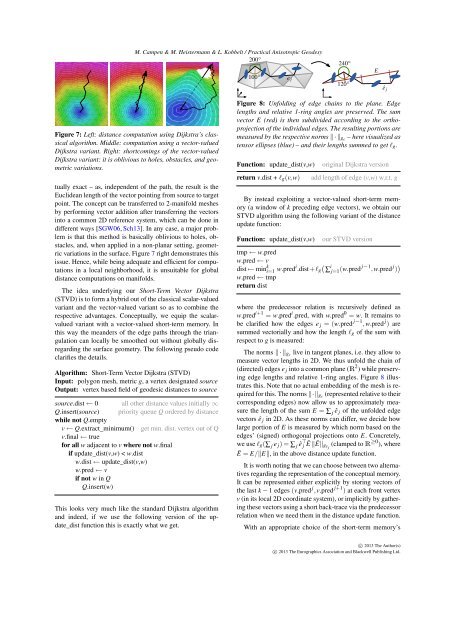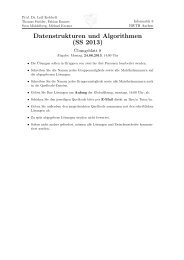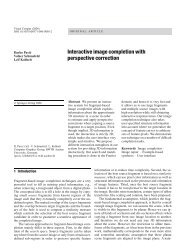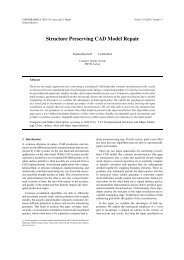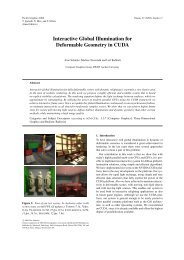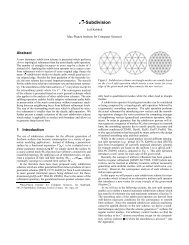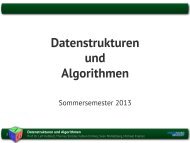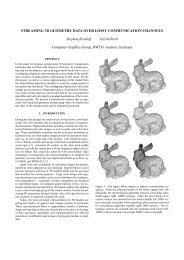Paper - Computer Graphics and Multimedia - RWTH Aachen ...
Paper - Computer Graphics and Multimedia - RWTH Aachen ...
Paper - Computer Graphics and Multimedia - RWTH Aachen ...
You also want an ePaper? Increase the reach of your titles
YUMPU automatically turns print PDFs into web optimized ePapers that Google loves.
M. Campen & M. Heistermann & L. Kobbelt / Practical Anisotropic Geodesy<br />
200 ◦ 120 ◦<br />
240 ◦ E<br />
100 ◦<br />
e j<br />
ê j<br />
Figure 7: Left: distance computation using Dijkstra’s classical<br />
algorithm. Middle: computation using a vector-valued<br />
Dijkstra variant. Right: shortcomings of the vector-valued<br />
Dijkstra variant: it is oblivious to holes, obstacles, <strong>and</strong> geometric<br />
variations.<br />
tually exact – as, independent of the path, the result is the<br />
Euclidean length of the vector pointing from source to target<br />
point. The concept can be transferred to 2-manifold meshes<br />
by performing vector addition after transferring the vectors<br />
into a common 2D reference system, which can be done in<br />
different ways [SGW06, Sch13]. In any case, a major problem<br />
is that this method is basically oblivious to holes, obstacles,<br />
<strong>and</strong>, when applied in a non-planar setting, geometric<br />
variations in the surface. Figure 7 right demonstrates this<br />
issue. Hence, while being adequate <strong>and</strong> efficient for computations<br />
in a local neighborhood, it is unsuitable for global<br />
distance computations on manifolds.<br />
The idea underlying our Short-Term Vector Dijkstra<br />
(STVD) is to form a hybrid out of the classical scalar-valued<br />
variant <strong>and</strong> the vector-valued variant so as to combine the<br />
respective advantages. Conceptually, we equip the scalarvalued<br />
variant with a vector-valued short-term memory. In<br />
this way the me<strong>and</strong>ers of the edge paths through the triangulation<br />
can locally be smoothed out without globally disregarding<br />
the surface geometry. The following pseudo code<br />
clarifies the details.<br />
Algorithm: Short-Term Vector Dijkstra (STVD)<br />
Input: polygon mesh, metric g, a vertex designated source<br />
Output: vertex based field of geodesic distances to source<br />
source.dist ← 0 all other distance values initially ∞<br />
Q.insert(source) priority queue Q ordered by distance<br />
while not Q.empty<br />
v ← Q.extract_minimum() get min. dist. vertex out of Q<br />
v.final ← true<br />
for all w adjacent to v where not w.final<br />
if update_dist(v,w) < w.dist<br />
w.dist ← update_dist(v,w)<br />
w.pred ← v<br />
if not w in Q<br />
Q.insert(w)<br />
This looks very much like the st<strong>and</strong>ard Dijkstra algorithm<br />
<strong>and</strong> indeed, if we use the following version of the update_dist<br />
function this is exactly what we get.<br />
Figure 8: Unfolding of edge chains to the plane. Edge<br />
lengths <strong>and</strong> relative 1-ring angles are preserved. The sum<br />
vector E (red) is then subdivided according to the orthoprojection<br />
of the individual edges. The resulting portions are<br />
measured by the respective norms ‖·‖ ge – here visualized as<br />
tensor ellipses (blue) – <strong>and</strong> their lengths summed to get l g.<br />
Function: update_dist(v,w)<br />
return v.dist + l g(v,w)<br />
original Dijkstra version<br />
add length of edge (v,w) w.r.t. g<br />
By instead exploiting a vector-valued short-term memory<br />
(a window of k preceding edge vectors), we obtain our<br />
STVD algorithm using the following variant of the distance<br />
update function:<br />
Function: update_dist(v,w)<br />
our STVD version<br />
tmp ← w.pred<br />
w.pred ← v<br />
dist← min k i=1 w.predi .dist+l g<br />
(<br />
∑<br />
i<br />
j=1 (w.pred j−1 ,w.pred j ) )<br />
w.pred ← tmp<br />
return dist<br />
where the predecessor relation is recursively defined as<br />
w.pred i+1 = w.pred i .pred, with w.pred 0 = w. It remains to<br />
be clarified how the edges e j = (w.pred j−1 ,w.pred j ) are<br />
summed vectorially <strong>and</strong> how the length l g of the sum with<br />
respect to g is measured:<br />
The norms ‖ · ‖ ge live in tangent planes, i.e. they allow to<br />
measure vector lengths in 2D. We thus unfold the chain of<br />
(directed) edges e j into a common plane (R 2 ) while preserving<br />
edge lengths <strong>and</strong> relative 1-ring angles. Figure 8 illustrates<br />
this. Note that no actual embedding of the mesh is required<br />
for this. The norms ‖·‖ ge (represented relative to their<br />
corresponding edges) now allow us to approximately measure<br />
the length of the sum E = ∑ j ê j of the unfolded edge<br />
vectors ê j in 2D. As these norms can differ, we decide how<br />
large portion of E is measured by which norm based on the<br />
edges’ (signed) orthogonal projections onto E. Concretely,<br />
we use l g(∑ j e j ) = ∑ j ê ⊤ j Ē ‖Ē‖ gê j<br />
(clamped to R ≥0 ), where<br />
Ē = E/‖E‖, in the above distance update function.<br />
It is worth noting that we can choose between two alternatives<br />
regarding the representation of the conceptual memory.<br />
It can be represented either explicitly by storing vectors of<br />
the last k − 1 edges (v.pred j ,v.pred j+1 ) at each front vertex<br />
v (in its local 2D coordinate system), or implicitly by gathering<br />
these vectors using a short back-trace via the predecessor<br />
relation when we need them in the distance update function.<br />
With an appropriate choice of the short-term memory’s<br />
c○ 2013 The Author(s)<br />
c○ 2013 The Eurographics Association <strong>and</strong> Blackwell Publishing Ltd.


